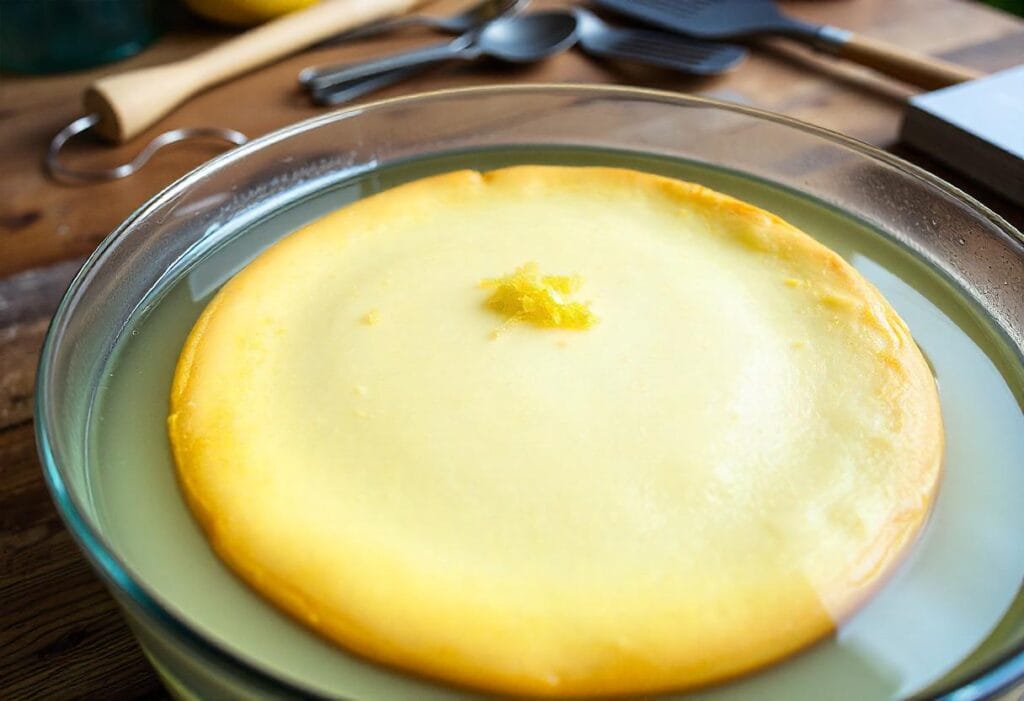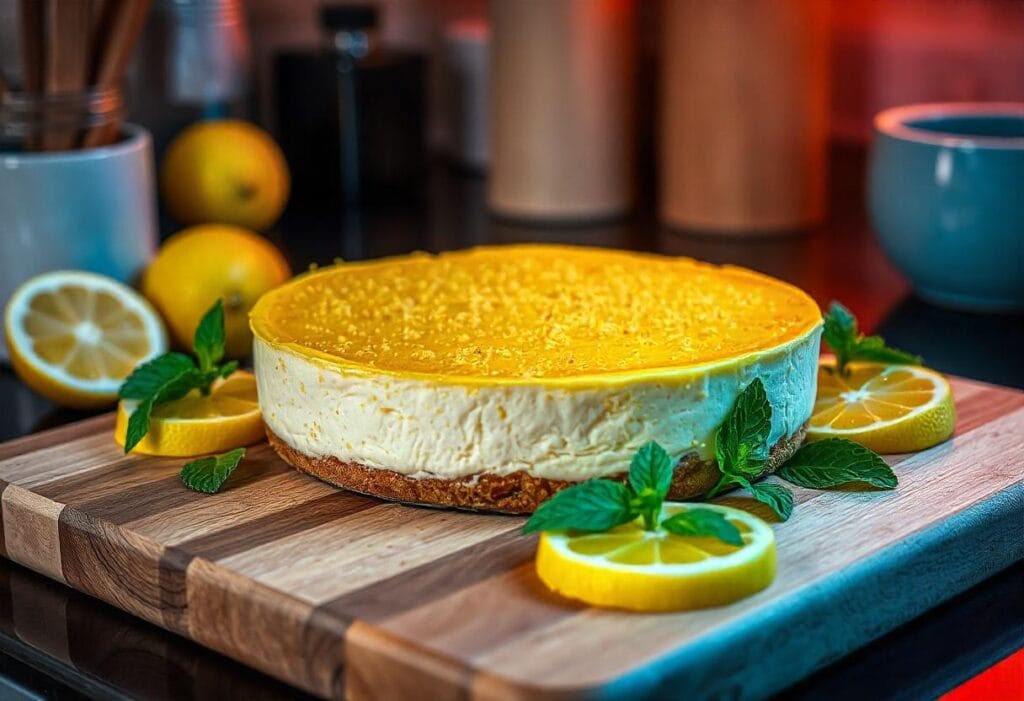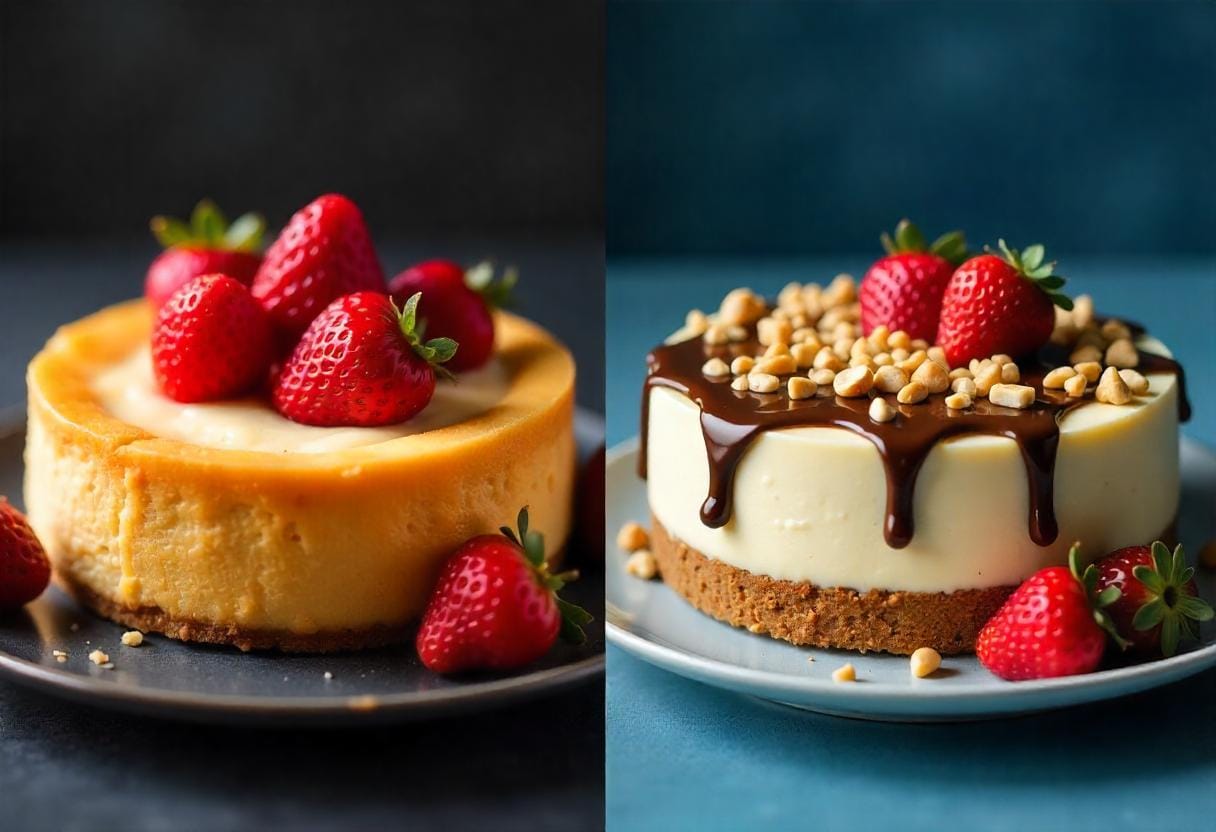Table of Contents
Cheesecake—a dessert loved by many but understood by few. One of the most common questions people ask is, “Should cheesecake be baked or not?” The truth is, both baked and no-bake cheesecakes have their merits, and the choice depends on personal preference, occasion, and even the level of effort you’re willing to put in. Let’s dive into the creamy world of cheesecakes and uncover the secrets behind baked and no-bake versions.
Understanding the Two Types of Cheesecake: Baked vs. No-Bake
Cheesecake may seem like a simple dessert, but its versatility is what makes it special. At its core, it’s all about balancing creaminess and flavor. However, baked and no-bake cheesecakes achieve this balance in entirely different ways.
What Defines a Baked Cheesecake?
Baked cheesecake is the traditional version most people know and love. It’s made with a base of cream cheese, eggs, sugar, and flavorings, then baked in an oven. The magic happens as the eggs cook and firm up the batter, giving it that dense yet creamy texture.
« Baked cheesecake is like a cozy blanket on a cold day—rich, comforting, and undeniably satisfying. »
| Nutrient (Per Slice of Baked Cheesecake) | Amount |
|---|---|
| Calories | ~350 kcal |
| Protein | ~7 g |
| Fat | ~25 g |
| Carbohydrates | ~30 g |

What Makes a No-Bake Cheesecake Unique?
No-bake cheesecake skips the oven entirely, relying on ingredients like gelatin or whipped cream to set the batter. It’s chilled in the refrigerator until firm, resulting in a lighter, more mousse-like texture.
« No-bake cheesecake is like a summer breeze—light, airy, and effortlessly refreshing. »
| Nutrient (Per Slice of No-Bake Cheesecake) | Amount |
|---|---|
| Calories | ~300 kcal |
| Protein | ~5 g |
| Fat | ~20 g |
| Carbohydrates | ~25 g |
The Science Behind Cheesecake: How Baking Affects Texture
To truly understand the difference, let’s break down the science of each method.
The Role of Eggs in Baked Cheesecakes
Eggs are the key to baked cheesecake’s texture. When heated, the proteins in eggs coagulate, creating structure and stability. This process is what gives baked cheesecake its dense, sliceable consistency.
- Pro Tip: Avoid overmixing the eggs, as this can introduce air bubbles, leading to cracks during baking.
Gelatin and Chilling: The Secret to No-Bake Cheesecakes
For no-bake cheesecakes, gelatin or whipped cream acts as the thickening agent. Gelatin sets the batter into a firm yet creamy texture, while whipped cream adds a light, fluffy quality.
- Pro Tip: Bloom gelatin properly by soaking it in cold water before dissolving it in warm liquid to avoid lumps.
« Think of baked cheesecake as a sturdy house built with bricks (eggs) and no-bake cheesecake as a tent held up by poles (gelatin). »

Pros and Cons of Baked Cheesecakes
Baked cheesecakes are beloved for their richness and depth of flavor, but they’re not without challenges.
Advantages of Baking Cheesecake
- Superior Texture: Baked cheesecakes are dense, creamy, and smooth.
- Rich Flavor: The baking process enhances flavors, especially in vanilla and chocolate versions.
- Versatility: You can experiment with swirls, layers, or add-ins like fruits and nuts.
Common Challenges with Baked Cheesecakes
- Cracks on the Surface: Caused by overbaking or sudden temperature changes.
- Longer Preparation Time: Baking and cooling take time and patience.
- Requires Precise Baking Techniques: A water bath and proper cooling are essential to avoid imperfections.
« Baked cheesecake is a labor of love, but the results are worth every minute. »
Pros and Cons of No-Bake Cheesecakes
No-bake cheesecakes are easy to make and perfect for beginners, but they come with their own set of quirks.
Why Choose a No-Bake Cheesecake?
- Quick and Simple: No oven needed, making it ideal for hot days.
- Light and Airy Texture: Great for those who prefer less dense desserts.
- Customizable: Can be made with a variety of flavors and toppings.
Limitations of No-Bake Cheesecakes
- Less Flavor Depth: Skipping the baking process means flavors don’t develop as intensely.
- Soft Texture: No-bake cheesecakes are less firm, which might not suit everyone’s preferences.
- Dependent on Chilling: Requires refrigeration for several hours, so it’s not a last-minute dessert.
« No-bake cheesecake is like a quick fix—it’s easy and delicious, but it doesn’t always satisfy that craving for depth. »
Key Differences Between Baked and No-Bake Cheesecakes
Let’s break it down further by comparing the two side by side.
| Feature | Baked Cheesecake | No-Bake Cheesecake |
|---|---|---|
| Texture | Dense and creamy | Light and mousse-like |
| Preparation Time | Longer due to baking/cooling | Shorter, no oven required |
| Thickening Agent | Eggs | Gelatin or whipped cream |
| Flavor Depth | Intense and rich | Subtle and delicate |
| Shelf Life | Longer when refrigerated | Shorter, best eaten fresh |
« Choosing between baked and no-bake is like choosing between a rich, velvety latte and a refreshing iced coffee—both are amazing, just in different ways. »
When to Choose Baked Cheesecake vs. No-Bake Cheesecake
Deciding between baked and no-bake cheesecake depends on the occasion, your preferences, and the effort you’re willing to put in. Let’s break it down further.
Celebrations and Special Occasions
For weddings, birthdays, or holidays, baked cheesecake often steals the show. Its rich flavor and firm texture make it feel more sophisticated and indulgent. Vanilla bean cheesecake with a fresh fruit topping or a decadent chocolate swirl cheesecake fits perfectly for these events.
« A baked cheesecake is like a black-tie event—it’s elegant, polished, and always leaves a lasting impression. »
No-bake cheesecakes, on the other hand, shine in casual settings. Picnics, barbecues, or last-minute dinner plans? A light and refreshing lemon or strawberry no-bake cheesecake will be a crowd-pleaser.
Time and Effort Considerations
- Baked Cheesecake: Ideal when you have time to bake, cool, and chill. It’s perfect for bakers who enjoy the process and don’t mind investing a few hours.
- No-Bake Cheesecake: A lifesaver for busy schedules. With minimal preparation, you can create a dessert that’s ready to impress after a few hours in the fridge.
« Think of no-bake cheesecakes as your dessert shortcut—fast, reliable, and delicious. »
Step-by-Step Guide to Making Each Type of Cheesecake
Whether you prefer baked or no-bake cheesecake, mastering the basics is essential. Here’s how to get it right every time.
Perfect Baked Cheesecake Recipe
Ingredients
| Ingredient | Quantity |
|---|---|
| Cream cheese (softened) | 32 oz |
| Sugar | 1 cup |
| Sour cream | 1 cup |
| Eggs | 4 large |
| Vanilla extract | 1 tsp |
| Graham cracker crust | Pre-made or homemade |
Instructions
- Preheat your oven to 325°F (163°C).
- Beat cream cheese and sugar until smooth.
- Add sour cream and vanilla, mixing well.
- Beat in eggs one at a time, just until combined.
- Pour into a graham cracker crust.
- Place the pan in a water bath and bake for 55–65 minutes.
- Turn off the oven and let the cheesecake cool gradually before refrigerating for at least 4 hours.
« Baking cheesecake is like creating art—every step builds toward a masterpiece. »

Easy No-Bake Cheesecake Recipe
Ingredients
| Ingredient | Quantity |
|---|---|
| Cream cheese (softened) | 16 oz |
| Heavy cream (whipped) | 1 cup |
| Powdered sugar | ¾ cup |
| Vanilla extract | 1 tsp |
| Gelatin | 1 tbsp |
| Graham cracker crust | Pre-made or homemade |
Instructions
- In a small bowl, bloom gelatin in 2 tbsp cold water for 5 minutes. Heat until dissolved.
- Beat cream cheese and powdered sugar until smooth.
- Fold in whipped cream and vanilla extract.
- Mix in the gelatin until well combined.
- Pour the mixture into a graham cracker crust.
- Chill in the refrigerator for at least 4 hours or overnight to set.
« No-bake cheesecakes are the epitome of simplicity—effortless yet delicious every time. »
Common Problems with Each Type of Cheesecake
Even seasoned bakers face challenges. Let’s troubleshoot the most common issues for both baked and no-bake cheesecakes.
Cracks in Baked Cheesecake: Causes and Fixes
Cause: Overmixing, baking at high temperatures, or cooling too quickly.
Solution:
- Always use a water bath to ensure even baking.
- Avoid overmixing the batter to prevent air bubbles.
- Let the cheesecake cool gradually in the oven with the door slightly open.
« A cracked cheesecake isn’t a failure—it’s rustic charm! Cover it with toppings, and no one will know. »
No-Bake Cheesecake Not Setting: Troubleshooting Tips
Cause: Incorrect gelatin preparation or insufficient chilling time.
Solution:
- Ensure gelatin is fully dissolved before adding it to the batter.
- Allow enough time in the refrigerator for the cheesecake to firm up.
« Patience is key with no-bake cheesecakes—the wait is always worth it! »
Expert Tips for Perfect Cheesecake, Baked or Not
Whether you’re team baked or team no-bake, these tips will ensure your cheesecake turns out flawless:
Using the Right Ingredients for Success
- Always use full-fat cream cheese for the best texture and flavor.
- Fresh, high-quality ingredients (like vanilla extract or fresh fruits) can elevate your cheesecake from good to great.
Best Tools and Techniques for Each Method
- For Baked Cheesecake: A springform pan and a water bath are non-negotiable. They ensure even baking and easy release.
- For No-Bake Cheesecake: An offset spatula is great for smoothing the batter, while a silicone mold can add creative shapes.
« Great tools make great cheesecakes—invest in the essentials for professional results. »
Advanced Cheesecake Tips for Perfect Results
Achieving the perfect cheesecake—whether baked or no-bake—requires attention to detail and a few pro techniques. Let’s level up your cheesecake-making skills.
Mastering the Water Bath
A water bath (bain-marie) is a key technique for baked cheesecakes. It ensures even heat distribution and prevents cracks.
- How to Prepare: Wrap the base of your springform pan tightly in aluminum foil to keep water out. Place the pan in a larger baking dish and fill it with hot water until it reaches halfway up the sides of the cheesecake pan.
- Why It Works: The steam from the water bath keeps the oven moist, which helps the cheesecake bake gently and evenly.
« Think of the water bath as your cheesecake’s personal spa day—it relaxes the batter and ensures a smooth, crack-free finish. »
Blooming Gelatin Like a Pro
For no-bake cheesecakes, properly blooming gelatin is essential to achieve the perfect set.
- Steps to Bloom Gelatin: Sprinkle powdered gelatin over cold water (usually 1 tbsp gelatin to 2 tbsp water) and let it sit for 5 minutes. Heat gently until dissolved, then add to your batter.
- Avoiding Mistakes: Don’t add hot gelatin directly to cold ingredients, as it can clump. Temper the gelatin by mixing a small amount of batter into the warm gelatin first, then combine it with the rest.
Creative Cheesecake Topping Ideas
Toppings not only enhance the flavor of your cheesecake but also add a visual “wow” factor. Here are some unique options to try:
Fruit-Based Toppings
- Berry Compote: Simmer fresh or frozen berries with a touch of sugar and lemon juice for a vibrant topping.
- Candied Citrus Slices: Thinly sliced oranges or lemons, cooked in sugar syrup, bring a sophisticated touch.
Chocolate and Nut Toppings
- Chocolate Ganache: Pour a glossy layer of ganache over your cheesecake for a decadent finish.
- Toasted Nuts: Add crunch with toasted almonds, pecans, or hazelnuts.
Unique Twists
- Edible Flowers: Garnish with pansies, violets, or marigolds for an elegant look.
- Savory Toppings: Yes, savory cheesecakes exist! Top with herbed cream cheese, smoked salmon, or roasted vegetables for a creative twist.
« Toppings are like accessories for your cheesecake—they transform it from delicious to dazzling. »
Fun Facts About Cheesecake
Cheesecake isn’t just a dessert; it’s a dessert with history, tradition, and even a few quirks.
- Ancient Origins: The first recorded cheesecakes date back to ancient Greece, where they were served to Olympic athletes. The original recipe included honey, cheese, and wheat.
- Cheesecake Around the World:
- Italy: Ricotta-based cheesecake, lighter and less dense.
- Germany: Käsekuchen, made with quark cheese and often flavored with lemon.
- Japan: Cotton cheesecake, known for its airy, soufflé-like texture.
- Cheesecake Day: July 30th is officially National Cheesecake Day—a perfect excuse to indulge!
« Cheesecake has traveled through time and across continents, proving its universal appeal. »
Pairing Cheesecake with Beverages
The right beverage can elevate your cheesecake experience. Here’s how to create perfect pairings:
Coffee and Tea Pairings
- Espresso with Chocolate Cheesecake: The bold bitterness of espresso complements the rich sweetness of chocolate.
- Earl Grey with Vanilla Cheesecake: The floral notes of Earl Grey enhance the subtle flavors of a classic cheesecake.
Wine and Cocktail Pairings
- Port Wine with Berry Cheesecake: The fruity sweetness of port wine pairs beautifully with berry-flavored cheesecakes.
- Limoncello with Lemon Cheesecake: A chilled glass of limoncello adds a zesty kick to citrus-based desserts.
« Pairing cheesecake with the right beverage turns dessert into a full sensory experience. »
Inspiring Cheesecake Serving Ideas
Take your cheesecake presentation to the next level with these creative serving ideas:
Cheesecake Jars
Layer mini no-bake cheesecakes in mason jars for a portable and visually appealing dessert. Alternate between crust, filling, and toppings for a colorful effect.
Cheesecake Bites
Make bite-sized cheesecakes using a muffin tin or silicone molds. These are perfect for parties or portion control.
Cheesecake Towers
Stack smaller cheesecakes in a tiered display for an eye-catching centerpiece. Decorate each tier with different toppings to showcase a variety of flavors.
« A beautifully served cheesecake isn’t just a treat for the taste buds—it’s a feast for the eyes. »
Expanding on Cheesecake FAQs
Can You Freeze Cheesecake?
Absolutely! Both baked and no-bake cheesecakes freeze well, making them a great make-ahead dessert.
- How to Freeze: Wrap slices or the whole cheesecake tightly in plastic wrap, then foil. Store for up to 3 months.
- Thawing: Let it thaw in the refrigerator overnight for the best texture.
« Freezing cheesecake is like saving a slice of happiness for later—it’s always there when you need it. »
What’s the Best Crust for Cheesecake?
While graham cracker crusts are traditional, you can get creative:
- Chocolate Cookie Crust: Perfect for chocolate or peanut butter cheesecakes.
- Oatmeal Cookie Crust: Adds a chewy, slightly sweet base.
- Gluten-Free Options: Use almond flour, crushed gluten-free cookies, or coconut flakes.
Conclusion: A Cheesecake for Every Occasion
The question, “Should cheesecake be baked or not?” doesn’t have a single answer because the best cheesecake depends on the moment. A baked cheesecake offers indulgence and depth, while a no-bake cheesecake delivers lightness and simplicity.
Whichever you choose, the magic of cheesecake lies in its ability to transform simple ingredients into a dessert that feels special. So, the next time you’re in the kitchen, remember: cheesecake isn’t just about following a recipe—it’s about crafting an experience that you’ll savor with every bite.
« Whether baked or not, cheesecake is always the right choice. »

